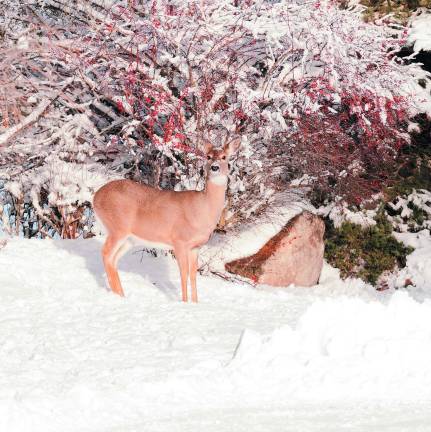Is it okay to feed the deer?

Meddling does more harm than good
New York State’s ban on feeding deer was enacted in 2002 through a series of emergency rule changes responding to the threat of chronic wasting disease. Before that, state law prohibited only the feeding of deer within 300 feet of a public road. However, Department of Environmental Conservation biologists have long recognized the detriments of feeding deer, which span well beyond the risks associated with communicable diseases, and include behavioral, social, and ecological consequences. (Note: There’s no evidence that chronic wasting disease, a fatal brain and nervous system disease, is currently in New York.)
During harsh winters, some deer do die. Fawns, injured deer, or those that are otherwise in poorer nutritional condition are the most vulnerable. Deer that inhabit quality summer and fall habitat generally enter winter in good nutritional and physiological condition and thus are better prepared to survive winter extremes.
Why can you feed some animals but not others? Because the risks (social, ecological, behavioral, disease) may be greater and more apparent with species like deer and bear than other wildlife. However, even backyard feeding of birds entails some risk (vulnerability to predation, disease transfer) and is unnecessary for the birds’ survival.
Further complicating the issue are the differences in local regulations on public baiting and feeding of various wildlife species. Some states ban feeding deer while others condone it, which can send a mixed message. The fact is that public policies do not always reflect best science or recommendations of wildlife managers.
DEC encourages people to enjoy observing deer without artificially concentrating them with human-provided supplemental food, which may be directly or indirectly harmful.
There is one thing you can do, however, without running afoul of the law: the cutting of hardwood, and in some cases softwood browse, has been a long standing DEC recommendation. See dec.ny.gov and search “feeding deer” for pros and cons and pointers, like how to “hinge” a young tree by cutting it close to the ground and pushing it over. In light of the new concerns for the introduction and spread of chronic wasting disease, browse cutting is even more acceptable because the risks normally associated with artificial foods and high deer concentrations are greatly reduced. In addition to providing immediate nutrition, the long term benefits of browse cutting can also result in improvement of the overall deer winter habitat.
- Compiled from DEC spokeswoman Wendy Rosenbach and dec.ny.gov
Supplementing Mother Nature, just a bit
Coming from an urban area, it was a thrill to look out our window and see deer walking casually across the property, munching grass. Or watch a family of foxes cavorting under our kids’ trampoline while their mother kept an eye out.
We’ve grown used to it now, nearly 30 years later. It’s not a novelty anymore but it still sparks joy.
In the dead of winter, when the ground is covered in snow, we buy deer food and put it out for the deer that trudge through our yard looking for nourishment. Sometimes we also put out a salt lick. We don’t spend our winters working to feed the hungry deer. It’s an occasional thing we do at times when there is little else available to them.
We know it’s illegal, although it wasn’t when we started. We thought it was the humane thing to do after seeing the animals day after day, searching for food. We know the reasons we shouldn’t – overpopulation, a possible increase in deer-car collisions, over-browsing in our area, familiarity with humans – but sometimes we do it anyway.
We would never put food out for bears, and when they have appeared at our trash can, we immediately take measures to avoid it happening again. We put our trash cans in a locked shed from spring through fall when bears are active. It keeps the raccoons at bay as well. We do not have bird feeders.
So why the special treatment for deer? I’m not quite sure. Yes, deer have been a nuisance at times. They’ve eaten our landscaping and damaged three of our cars over the years. We don’t believe our incidental feedings – or anyone else’s - have been the cause. The way we see it, deer aren’t predatory. They have never gotten comfortable with us, running into the woods as soon as they see our car or hear a door close. We are not drawing more deer to our yard – we see the number that cut through all the time. We are supplementing Mother Nature. Just a bit.
After three decades, we still marvel at these beautiful creatures that share our environment. All of them. Even if we don’t feed them all.
Warwick resident
Name withheld